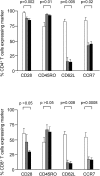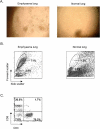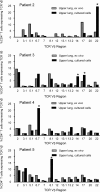Oligoclonal CD4+ T cells in the lungs of patients with severe emphysema
- PMID: 15937291
- PMCID: PMC2718531
- DOI: 10.1164/rccm.200410-1332OC
Oligoclonal CD4+ T cells in the lungs of patients with severe emphysema
Abstract
Rationale: Within the lungs of patients with severe emphysema, inflammation continues despite smoking cessation. Foci of T lymphocytes in the small airways of patients with emphysema have been associated with disease severity. Whether these T cells play an important role in this continued inflammatory response is unknown.
Objective: The aim of this study was to determine if T cells recruited to the lungs of subjects with severe emphysema contain oligoclonal T-cell populations, suggesting their accumulation in response to antigenic stimuli.
Methods: Lung T-cell receptor (TCR) Vbeta repertoire from eight patients with severe emphysema and six control subjects was evaluated at the time of tissue procurement (ex vivo) and after 2 weeks of culture with interleukin 2 (in vitro). Junctional region nucleotide sequencing of expanded TCR-Vbeta subsets was performed.
Results: No significantly expanded TCR-Vbeta subsets were identified in ex vivo samples. However, T cells grew from all emphysema (n = 8) but from only one of the control lung samples (n = 6) when exposed to interleukin 2 (p = 0.0013). Within the cultured cells, seven major CD4-expressing TCR-Vbeta subset expansions were identified from five of the patients with emphysema. These expansions were composed of oligoclonal populations of T cells that had already been expanded in vivo.
Conclusion: Severe emphysema is associated with inflammation involving T lymphocytes that are composed of oligoclonal CD4+ T cells. These T cells are accumulating in the lung secondary to conventional antigenic stimulation and are likely involved in the persistent pulmonary inflammation characteristic of severe emphysema.
Figures






Similar articles
-
Persistence of lung CD8 T cell oligoclonal expansions upon smoking cessation in a mouse model of cigarette smoke-induced emphysema.J Immunol. 2008 Dec 1;181(11):8036-43. doi: 10.4049/jimmunol.181.11.8036. J Immunol. 2008. PMID: 19017996
-
Characterization of the interstitial lung and peripheral blood T cell receptor repertoire in cigarette smokers.Am J Respir Cell Mol Biol. 2005 Feb;32(2):142-8. doi: 10.1165/rcmb.2004-0239OC. Epub 2004 Nov 11. Am J Respir Cell Mol Biol. 2005. PMID: 15539458
-
T-Cell repertoire in the blood and lungs of atopic asthmatics before and after ragweed challenge.Am J Respir Cell Mol Biol. 1998 Mar;18(3):370-83. doi: 10.1165/ajrcmb.18.3.2935. Am J Respir Cell Mol Biol. 1998. PMID: 9490655
-
Activated oligoclonal CD4+ T cells in the lungs of patients with severe emphysema.Proc Am Thorac Soc. 2006 Aug;3(6):486. doi: 10.1513/pats.200603-062MS. Proc Am Thorac Soc. 2006. PMID: 16921120 Free PMC article. No abstract available.
-
TCR expression of activated T cell clones in the lungs of patients with pulmonary sarcoidosis.J Immunol. 1994 Nov 1;153(9):4291-302. J Immunol. 1994. PMID: 7930629
Cited by
-
Increased levels of (class switched) memory B cells in peripheral blood of current smokers.Respir Res. 2009 Nov 12;10(1):108. doi: 10.1186/1465-9921-10-108. Respir Res. 2009. PMID: 19909533 Free PMC article.
-
Heme oxygenase-1 prevents smoke induced B-cell infiltrates: a role for regulatory T cells?Respir Res. 2008 Feb 6;9(1):17. doi: 10.1186/1465-9921-9-17. Respir Res. 2008. PMID: 18252008 Free PMC article.
-
The role of vasculature and angiogenesis in respiratory diseases.Angiogenesis. 2024 Aug;27(3):293-310. doi: 10.1007/s10456-024-09910-2. Epub 2024 Apr 5. Angiogenesis. 2024. PMID: 38580869 Free PMC article. Review.
-
Current concepts on oxidative/carbonyl stress, inflammation and epigenetics in pathogenesis of chronic obstructive pulmonary disease.Toxicol Appl Pharmacol. 2011 Jul 15;254(2):72-85. doi: 10.1016/j.taap.2009.10.022. Epub 2011 Feb 4. Toxicol Appl Pharmacol. 2011. PMID: 21296096 Free PMC article. Review.
-
Microarray analysis of long non-coding RNAs in COPD lung tissue.Inflamm Res. 2015 Feb;64(2):119-26. doi: 10.1007/s00011-014-0790-9. Epub 2014 Dec 27. Inflamm Res. 2015. PMID: 25542208
References
-
- Centers for Disease Control and Prevention. Current estimates from the National Health Interview Survey, 1995: vital and health statistics. Washington, DC: U.S. Government Printing Office; 1996. DHHS Publication No. (PHS) 96-1527.
-
- Lopez AD, Murray CC. The global burden of disease, 1990–2020. Nat Med 1998;4:1241–1243. - PubMed
-
- Sullivan SD, Ramsey SD, Lee TA. The economic burden of COPD. Chest 2000;117:5S–9S. - PubMed
-
- Pauwels RA, Buist AS, Calverley PM, Jenkins CR, Hurd SS. Global strategy for the diagnosis, management, and prevention of chronic obstructive pulmonary disease. NHLBI/WHO Global Initiative for Chronic Obstructive Lung Disease (GOLD) workshop summary. Am J Respir Crit Care Med 2001;163:1256–1276. - PubMed
Publication types
MeSH terms
Substances
Grants and funding
LinkOut - more resources
Full Text Sources
Other Literature Sources
Research Materials

